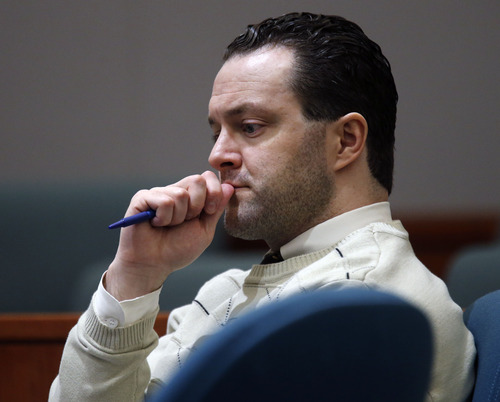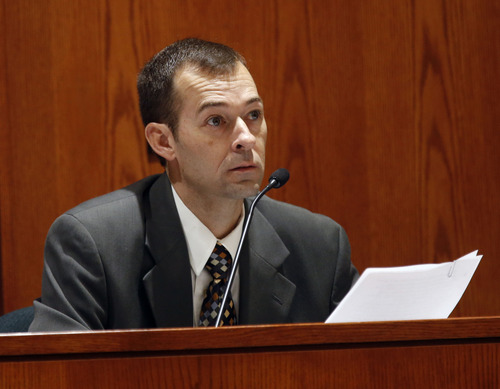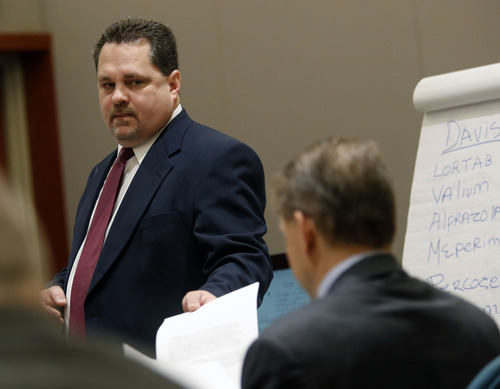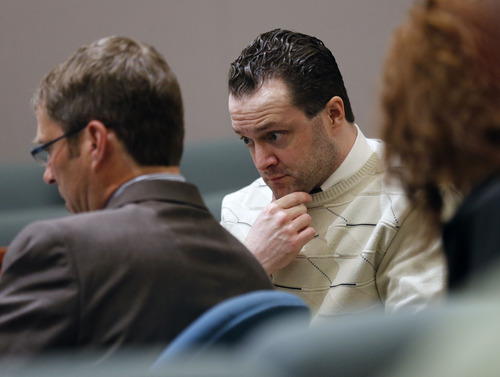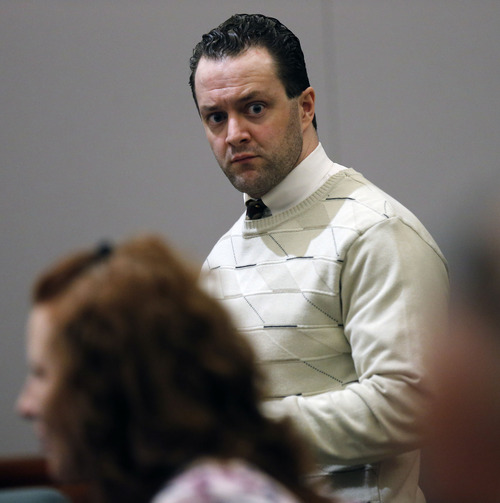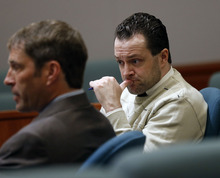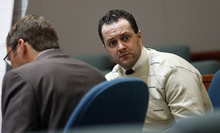This is an archived article that was published on sltrib.com in 2013, and information in the article may be outdated. It is provided only for personal research purposes and may not be reprinted.
Farmington • A Utah medical examiner testified Friday that Ethan Stacy's death in 2010 was caused by a combination of drug toxicity, scalding injuries and aspiration pneumonia.
During a hearing in 2nd District Court, deputy chief medical examiner Edward Leis classified Ethan's death as a homicide.
His testimony came during the third day of a preliminary hearing for Nathan Sloop, 34, who is charged with aggravated murder, intentionally inflicting serious physical injury on a child, obstructing justice and abuse or desecration of a human body in the death of his stepson. His wife and Ethan's mother, Stephanie Sloop, 30, faces the same charges. No date has been set for a preliminary hearing in her case.
Prosecutors intend to seek the death penalty for Nathan Sloop, according to court documents.
Investigators believe Ethan died on May 8, 2010. Three days later, Nathan Sloop led them to the boy's badly beaten body, which was buried in a shallow grave near Powder Mountain Ski Resort in Weber County. The couple confessed to burying the boy, and Nathan Sloop told investigators he used a hammer to disfigure Ethan's face and teeth after Stephanie Sloop told him she was worried about dental records being used to identify her son.
Charging documents state the Layton couple engaged in multiple acts of "severe abuse" between April 29 and May 8 in 2010 that led to Ethan's death, including "beatings, burning, drugging, isolating, malnourishing, leaving the child alone and unattended while suffering, and refusing to seek vital life-sustaining medical attention."
Leis said Friday that it took two days for medical examiners to thoroughly examine Ethan's body, which came to his office still wrapped in the garbage bags in which the body was found.
He testified that Ethan had second- and third-degree burns on the soles of his feet and the back of his legs, likely from hot water in a bathtub. Based on where the injuries were found, Leis said it was unlikely the child would have stepped into the bathtub and realized it was too hot, or accidentally turned the faucet to the point where he burned himself.
According to police probable cause statements, Stephanie Sloop told police that on May 7, Nathan Sloop told her Ethan had burned himself by turning up the hot water when Nathan Sloop left the bathroom. But Nathan Sloop admitted to police that he had scalded the boy, according to testimony.
The severity of the scalding injuries likely would have caused the wounds to leak fluid, Leis said, which would have caused Ethan to become dehydrated. And dehydration could have magnified the effects of drugs in Ethan's system, Leis said.
Alprazolam, commonly known as Xanax, was found in Ethan's body, along with antihistamines and a synthetic opiod similar to codeine, which is used to treat pain or cough.
Defense attorney Scott Williams noted during cross-examination that all of the medications found in Ethan's system, with the exception of Xanax, could be found in children's over-the-counter medications, such as Tylenol or Benadryl.
According to earlier testimony this week, the Sloops said they had treated Ethan with Benadryl and children's Tylenol. And they said they had consulted a chiropractor about his injuries and behavioral problems, although the boy was never physically examined.
David Andrenyak, assistant director of the lab at the Center for Human Toxicology at the University of Utah, testified Friday that the level of Xanax is Ethan's system was comparable to a normal adult dosage. But he could not say whether that would be considered a high level in a small child because of lack of research.
"This particular drug has not been characterized for a child in terms of study," he said. "I don't think I could feel that is a safe amount for a child. [But] there's just not a lot of information about it to make that conclusion."
Nathan Sloop had a prescription for Xanax, according to a Department of Professional Licensing document, which tracked the drugs Nathan Sloop was prescribed. In an 11-month period, he was given 4,146 pills, including Lortab, Valium, Percocet, an antihistamine and Xanax.
Nathan Sloop told investigators the pain pills were for his back.
According to Andrenyak, the levels of two antihistamines found in Ethan's system were slightly higher than the normal dosage for an adult. He said any of the drugs alone would not be fatal to the 4-year-old, but a combination of drugs, together with Ethan's scalding and blunt-force injuries, could have caused his death.
"There was no one single drug detected in the blood sample where the concentration was high enough to say, 'Yes, it was a clear-cut overdose,'" he said Friday.
Sloop's defense attorneys noted during cross-examination that a month after Ethan's death, some batches of children's Benadryl were recalled because their drug content was higher than the recommended dose. However, prosecutors countered that the Benadryl found in the Sloop home was not the same flavor or product number that was recalled in 2010.
Leis also said Ethan had aspiration pneumonia, which implies that he had foreign material — often stomach contents —in his lungs.
Prosecutors suggested the substance could have been feces that Nathan Sloop admitted putting in Ethan's mouth, while the defense suggested it might have been vomit. Leis said either one was possible but did not testify to anything specific found in the boy's lungs.
Though they did not contribute to Ethan's death, Leis also detailed several minor bruises found on Ethan's body, including his genitals. He noted that bruises on Ethan's forehead and the back of his head were found during an internal examination but were not visible on external exam.
Williams suggested the bruising was minor enough that it could have been inflicted during play, which Leis said was a possibility.
Leis said the injury to Ethan's genitals would have been caused by pinching, not a blunt-force injury. The defense suggested the injury could have been inflicted by a zipper, but Leis said he would normally expect a skin abrasion, which was not present, from a zipper.
Leis also detailed a number of lacerations Ethan sustained after he died, including multiple blunt-force strikes to the head.
Leis noted that due to the way those injuries were inflicted, they likely were caused by the hammer found where Ethan was buried, and he was likely already wrapped in the garbage bags when the wounds were inflicted.
The hearing was set to end Friday, but Judge Glen Dawson scheduled an extra day of testimony for April 19, when a burn expert is expected to take the stand. At the end of the hearing, Dawson will decide if there is enough evidence to proceed to trial.
Twitter: @jm_miller



